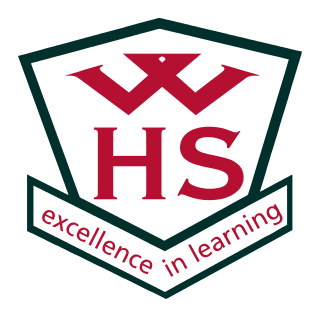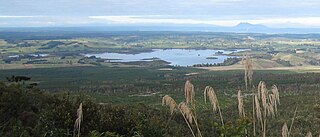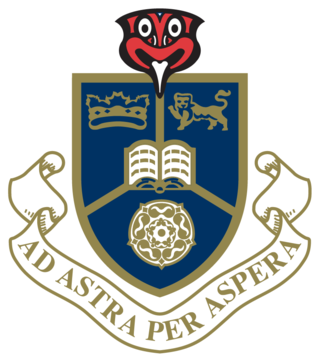
Rotorua is a city in the Bay of Plenty Region of New Zealand's North Island. The city lies on the southern shores of Lake Rotorua, from which it takes its name. It is the seat of the Rotorua Lakes District, a territorial authority encompassing Rotorua and several other nearby towns. Rotorua has an estimated resident population of 58,900, making it the country's 13th largest urban area, and the Bay of Plenty's second-largest urban area behind Tauranga.

Derek Francis Quigley is a New Zealand former politician. He was a prominent member of the National Party during the late 1970s and early 1980s, and was known for his support of free-market economics and trade liberalisation. Quigley left the National Party after clashing with its leadership, and later co-founded the ACT New Zealand party.

Wellington High School is a co-educational secondary school in the CBD of Wellington, New Zealand. It has a role of approximately 1500 students. It was founded in 1886 as the Wellington College of Design, to provide a more practical education than that offered by the existing schools. In 1905 it began admitted boys and girls, becoming the first co-educational secondary school in New Zealand. It is one of only two secondary schools in Wellington, and one of only a handful in the country, that does not have a school uniform.

Lake Rerewhakaaitu is a small, shallow lake in northern New Zealand, located 30 kilometres to the east of Rotorua. It is immediately south of the active volcano Mount Tarawera, and the geography was substantially altered by the 1886 eruption of Mount Tarawera.

Robin Hyde, the pseudonym used by Iris Guiver Wilkinson, was a South African-born New Zealand poet, journalist and novelist.

Rotorua Boys' High School (RBHS) is a state school educating boys from Year 9 to Year 13. It is situated just outside the Rotorua CBD at the intersection of Old Taupo Road and Pukuatua Street in Rotorua, New Zealand. The school is governed by an elected School Board, of which the Principal is ex officio a member under guidelines laid down by the New Zealand Ministry of Education. With Māori enrolment exceeding 75% of the school’s intake, the largest per capita in New Zealand, RBHS has been a longstanding recipient of funding from its Ngāti Whakaue endowment that assisted the construction of the school’s hostel, and the purchase of a computer laboratory. RBHS is noted for its performance in sport, with 4 Olympians among its notable alumni, and for having won the Prime Minister of New Zealand Supreme Award for Excellence in Education and the Excellence in Leading Award, making it the top school in the country for 2019. Its current principal, Chris Grinter, is the longest serving in the school's history, and in 2022, he received a New Zealand Order of Merit for services to education and Māori.

John Paul College is a Catholic secondary school in Rotorua, New Zealand. The co-educational school caters for students in years 7 to 13. It was opened in 1987 and combined two existing schools, Edmund Rice College and MacKillop College. The school was founded to serve the Catholic families of Rotorua. John Paul College was named for Pope John Paul II.

The Aamber Pegasus is a home computer first produced in New Zealand in 1981 by Technosys Research Labs.
Robina Thomson Cameron, known as Ruby Cameron, was a New Zealand district nurse, community leader and nursing inspector. She was born in Edinburgh, Midlothian, Scotland, on 15 April 1892, coming to New Zealand in 1911 where she trained at Cook Hospital, Gisborne.
The NEXT Foundation is a privately funded New Zealand strategic philanthropy foundation launched in March 2014. It has a mandate to spend down $100 million over 10 years into environmental and educational projects that will benefit future generations of New Zealanders. NEXT Foundation invests in a small number of multi year initiatives with both financial and non financial support. It targets initiatives that are transformational, inspirational and run in a business like way.
The 2017 New Year Honours in New Zealand were appointments by Elizabeth II in her right as Queen of New Zealand, on the advice of the New Zealand government, to various orders and honours to reward and highlight good works by New Zealanders, and to celebrate the passing of 2016 and the beginning of 2017. They were announced on 31 December 2016.
The 1960 New Year Honours in New Zealand were appointments by Elizabeth II on the advice of the New Zealand government to various orders and honours to reward and highlight good works by New Zealanders. The awards celebrated the passing of 1959 and the beginning of 1960, and were announced on 1 January 1960.
The 1978 New Year Honours in New Zealand were appointments by Elizabeth II on the advice of the New Zealand government to various orders and honours to reward and highlight good works by New Zealanders. The awards celebrated the passing of 1977 and the beginning of 1978, and were announced on 31 December 1977.
The information and communications technology industry in New Zealand is a rapidly growing sector. The technology sector overall employs over 120,000 people, and technology is New Zealand's third largest export sector, accounting for $8.7 billion of exports, with information technology creating 50,000 full time jobs, and about $1 billion in IT services exports.
The 1961 Queen's Birthday Honours in New Zealand, celebrating the official birthday of Elizabeth II, were appointments made by the Queen on the advice of the New Zealand government to various orders and honours to reward and highlight good works by New Zealanders. They were announced on 10 June 1961.
The 1984 Queen's Birthday Honours in New Zealand, celebrating the official birthday of Elizabeth II, were appointments made by the Queen in her right as Queen of New Zealand, on the advice of the New Zealand government, to various orders and honours to reward and highlight good works by New Zealanders. They were announced on 16 June 1984.
The 1997 Queen's Birthday Honours in New Zealand, celebrating the official birthday of Queen Elizabeth II, were appointments made by the Queen in her right as Queen of New Zealand, on the advice of the New Zealand government, to various orders and honours to reward and highlight good works by New Zealanders. They were announced on 2 June 1997.
The 1978 Queen's Birthday Honours in New Zealand, celebrating the official birthday of Elizabeth II, were appointments made by the Queen in her right as Queen of New Zealand, on the advice of the New Zealand government, to various orders and honours to reward and highlight good works by New Zealanders. They were announced on 3 June 1978.
The 1984 New Year Honours in New Zealand were appointments by Elizabeth II on the advice of the New Zealand government to various orders and honours to reward and highlight good works by New Zealanders. The awards celebrated the passing of 1983 and the beginning of 1984, and were announced on 31 December 1983.








